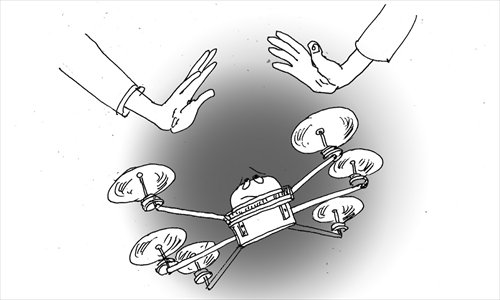HOME >> BUSINESS
Military-civilian integration faces various challenges
By Hu Weijia Source:Global Times Published: 2015-11-30 0:03:08
Optimism should be cautious as institutional barriers remain

Illustration: Luo Xuan/GT
High-tech manufacturing industries in China such as drones and supercomputers are likely to see major opportunities for development over the next few years as the country deepens national military reform and improves military-civilian integration in research and production. However, given that certain institutional barriers remain, expectations should not be too high.
President Xi Jinping said last week that there should be breakthroughs in reforms of the country's armed forces by 2020, and experts have forecast that comprehensive military reform will be rolled out in China in the next few years.
This unprecedented military reform program is expected to boost military-civilian integration in research and production. According to a recent media report by Shanghai Securities News, management mechanisms will be upgraded in a bid to improve the efficiency of communication between the two sectors.
In fact, the process of military-civilian integration has already accelerated since the beginning of this year. After Xi upgraded military and civilian integration to the status of a national strategy in March, the Ministry of Industry and Information Technology on November 20 released a new catalogue of technologies transferred from the military. The technologies cover nine major areas including intelligent manufacturing, general aviation, marine engineering equipment and power transmission.
People are aware of China's recent success in some high-tech manufacturing sectors, such as production of passenger aircraft, although it's uncertain whether this can be seen as an example of greater military-civilian integration.
China has already become the world's largest market for some high-tech products including industrial robots. However, a great number of the products sold in China are imported from global heavyweights in the US and Europe, while domestic firms mainly produce low-end products due to a lack of core technology.
As a result of military reform and improved military-civilian integration, the ban on civilian use of certain military technologies is expected to be lifted in the next few years. The question now is whether Chinese enterprises in high-tech manufacturing industries can seize the opportunity to cement their position in the global market and even challenge the dominance of Western companies in some areas.
However, there should not be excessive optimism in this regard, and the country may need to think calmly and seriously about how to deal with various challenges in improving the efficiency of military-civilian integration.
First, even though Chinese military enterprises have some unique advantages in high-tech areas such as aviation equipment, there is an ineffective mechanism for approving military technologies for use in civilian areas and the non market-oriented intellectual property rights of military technologies create barriers to military-civilian integration.
Some State-owned military enterprises have embarked upon production of civilian goods and have used technologies transferred from the military in their civilian business. However, transfer of military technology between different companies is more difficult and it is relatively hard for private firms to obtain technologies transferred from the military due to the lack of an effective market for technology exchange.
Second, Chinese private enterprises were not allowed to carry out research or production of military-use products until 2005, and one of the consequences is that some State-owned military enterprises may not be accustomed to fierce competition from private firms. Also, given that military enterprises enjoy adequate funding and orders for military products from the government, they may have less motivation to work on improving military-civilian integration.
Greater military-civilian integration is inevitable and will allow private enterprises to participate in the military industry. More than 1,000 private enterprises in China have gained approval to enter the sector, but the process may need to be further sped up.
Third, there is the fact that military enterprises often lag behind in terms of financing and responding to demand in a market-oriented way compared with their civilian competitors.
Nonetheless, the process of military-civilian integration is improving fast, and it is likely to offer greater opportunities for the development of high-tech manufacturing industries in China over the next five years, so long as the challenges can be dealt with.
The author is a reporter with the Global Times. bizopinion@globaltimes.com.cn
Posted in: It's Your Business